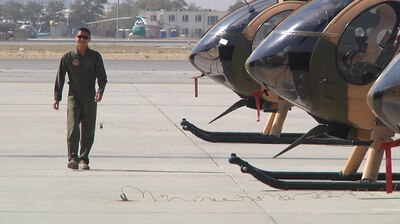
KABUL, Afghanistan, Oct. 2, 2018 —
He was still in high school when he decided he wanted to serve his country. As a teenager from Ghanzi Province he moved to Kabul to attend the National Military Academy of Afghanistan.
Upon graduation he dreamed of becoming a pilot in the Afghan Air Force, and in 2013 he got his chance.
“You know when I first came to the air force I did not even know how to get inside the aircraft, and my instructor took my hand and showed me how – he taught me how to become a pilot.”
It was during basic training at Shindand Air Base in Herat Province his NATO instructors saw his talent. They taught him not only to fly helicopters, but they taught him to train other Afghans as well. He primarily flew a MD-530. At the time the aircraft was only being used in training; however, in 2015 it would become a combat aircraft.
The pilot from Ghanzi was one of the first four Afghans ready to fly the MD-530 in combat. In August 2015, at the age of 26, he graduated from the mission-qualification course.
Three years later he is still in the fight.
On August 21, 2018, approximately nine armed ISIS-K terrorists commenced firing mortar rounds at the rate of one per minute for half an hour. It was the first day of Eid al-Adha. The insurgents firing the mortars hid near Eidgah mosque as they shot towards the presidential palace and Ministry of Defense just as Afghanistan President Ashraf Ghani was delivering his address for the Muslim holy festival.
In the sky overhead, that pilot from Ghanzi, now a 29-year-old major. After flying for six and half years he was no longer that kid who did not even know how to get in the cockpit.
“The Ministry of Defense Afghanistan Command and Control Center called me and they gave me a grid they told me they are shooting the rockets from this grid, so I put the grid on the GPS, and then when I arrived I saw the target and asked for permission to fire.”
He then fired five rockets at the insurgents while ground forces cleared the area.
“We really tried to shoot the target precisely to make sure that we should not hit the civilian people.”
No civilians were hit and the area was secured.
NATO’s Kabul Security Force was standing ready to assist.
“Our job in the Kabul Security Force is to really monitor what is going on in the city and offer advice and provide support to the Afghans. In this particular instance we were watching it very closely, and we watched it unfold, but the entire operation was Afghan-led from start to finish,” said U.K. Army Brigadier Simon Humphrey, Kabul Security Force commander.
Humphrey added that air to ground coordination is one of the hardest capabilities to execute.
Established in 2015, Resolute Support (RS) is a NATO-led, non-combat mission to train, advise and assist the Afghan National Defense and Security Forces (ANDSF), who assumed nationwide responsibility for Afghanistan’s security following the conclusion of the previous NATO-led International Security Assistance Force (ISAF) mission. Its purpose is to help the Afghan security forces and institutions develop the capacity to defend Afghanistan and protect its citizens in a sustainable manner.



